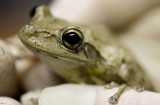Cuban Treefrogs
An Invasive Threat
The invasive Cuban treefrog is a nuisance to Florida homeowners, and the amphibian threatens Florida's native treefrog populations.
What Are Cuban Treefrogs?
While the Cuban treefrog, Osteopilus septentrionalis, is native to Cuba, the Cayman Islands, and the Bahamas, it is an introduced species in Florida. The frog can be found from the Florida Keys to Gainesville and Jacksonville, with sightings throughout Florida's panhandle and beyond.
Cuban treefrogs are the largest treefrog found in Florida and can grow to more than six inches in length. Other features include the following:
- Large "bug-eyed" eyes
- Large toepads—significantly larger than native treefrogs
- Rough or warty skin
- Wavy patterns or blotches on their back
- Various skin colors — usually creamy white to light brown but can also be green, gray, yellow, or a combination of colors
- Males have a distinct call that sounds like a squeaking door, often described as a "snoring rasp"
- Appear to have a yellow color where the legs meet the body
- Young Cuban treefrogs can have red eyes, light lines down their sides, and blue bones
Cuban treefrogs secrete an irritating substance, so you should not touch the animals with your bare hands. Keep your pets away from them, too.
Because Cuban treefrogs can be difficult to distinguish from native treefrogs, get help identifying treefrogs from UF/IFAS Wildlife or your local UF/IFAS Extension office.
Problems & Threats
Cuban treefrogs can be found in natural, suburban, agricultural, and urban settings.
Negative Impact on Native Species
In natural and urban settings, Cuban treefrogs eat Florida's native treefrogs, as well as lizards and many invertebrates.
Home Problems
Cuban treefrogs thrive in human-modified areas, and populations can be dense enough to be a nuisance. These treefrogs often enter homes through doors, windows, and plumbing.
Cuban treefrogs can cause the following problems in homes:
- Clogged drains
- Egg masses in pools and decorative ponds (which cause a subsequent increase of Cuban treefrogs around the home)
- Occupying nesting boxes meant for birds
- Burning and irritation of eyes and nose from contact with Cuban treefrogs
- Power interruptions because the frogs get into transformers and electrical switches and cause short circuits
What You Can Do
You can help manage this invasive species in and around your yard. Because Cuban treefrogs eat native frogs and other wildlife, reducing their negative impacts helps sustain Florida's natural environment.
Reporting Cuban Treefrogs
If you find a Cuban treefrog, email Dr. Steve A. Johnson of the University of Florida. In your email include:
- The county where you saw the frog
- A street address of the location for mapping purposes
- A digital photograph of the frog (if possible) for identification
Capture & Humane Euthanization
Because this invasive treefrog poses a significant threat to native treefrogs and causes many other problems, UF/IFAS recommends you capture and humanely euthanize Cuban treefrogs.
You can also reduce Cuban treefrog impacts by eliminating their eggs and potential breeding sites.
Be positive about the frog's identification before euthanizing what you believe to be a Cuban treefrog.
Catching Cuban Treefrogs by Hand
You can capture Cuban treefrogs by simply grabbing them from their perch sites. Be sure to wear rubber gloves or use a plastic grocery bag as a glove. Approach the frog and grasp it firmly in a continuous, swift movement.
Collecting Frogs in Pipes
You can also attract the frogs to hiding places where they can be easily captured and removed.
Place 3-foot long segments of 1½-inch diameter PVC pipe in the ground around your home and garden. After a few days or weeks, frogs will appear in the pipes.
To remove a frog from a pipe, pull the pipe out of the ground and place a clear plastic bag over one end. Insert a broom handle or other plunger device in the other end to scare the frog into the bag.
Let native treefrogs return inside the pipe.
Humanely Euthanizing Cuban Treefrogs
Remember to use gloves when touching the frog.
After positively identifying a frog as a Cuban treefrog, humanely euthanize by applying benzocaine ointment—a numbing agent used to treat skin pain and itching—to the frog's back. Name brand and generic products are available over-the-counter in tubes or sprays.
After the ointment is applied, place the frog in a sealable plastic bag for 15–20 minutes, so the benzocaine makes the frog unconscious.
Keep the frog in the bag, and place it in the freezer overnight. In the morning, throw it away in the trash. Do not throw live frogs in the trash.
For questions about Cuban treefrogs and their impacts, contact Dr. Steve Johnson or your local Extension office.
Adapted and excerpted from:
S. Johnson, The Cuban Treefrog (Osteopilus septentrionalis) in Florida (WEC218), Department of Wildlife Ecology and Conservation (rev. 09/2013).
S. Johnson, Florida Invader: Cuban Treefrog (WEC301), Department of Wildlife Ecology and Conservation (rev. 02/2014).

Related Sites & Articles
- Hot Topics
- Nuisance Wildlife
- UF/IFAS Publications
- Frogs and Toads
- UF/IFAS Sites
- Cuban Treefrog
- Florida's Frogs
- Frogs & Toads of Florida

